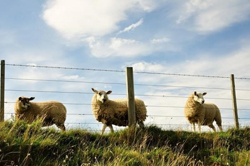 Fences come in many shapes, sizes and materials, and can serve many purposes. As a contractor, you may be asked to build a small white picket fence to be a decorative border around a Victorian style home, or construct a 20 mile wire fence around the perimeter of a ranch. According to Charles Sanders, in his article for Backwoods Home Magazine entitled How to Build a Fence for your Homestead, “One of the basic fixtures on a homestead is fencing. Fences are used to keep animals in, or out, of areas. They are used to mark boundaries or provide attractive borders to properties.
Fences come in many shapes, sizes and materials, and can serve many purposes. As a contractor, you may be asked to build a small white picket fence to be a decorative border around a Victorian style home, or construct a 20 mile wire fence around the perimeter of a ranch. According to Charles Sanders, in his article for Backwoods Home Magazine entitled How to Build a Fence for your Homestead, “One of the basic fixtures on a homestead is fencing. Fences are used to keep animals in, or out, of areas. They are used to mark boundaries or provide attractive borders to properties.
“You may think that a fence doesn't need to be all that sturdy to contain your particular livestock. However, a horse using the top wire to scratch its neck, or a cow snuffling under the bottom wire to reach better grass can soon cause a lot of sagging and premature fence failure. In addition, you may be more concerned with keeping critters out than in. This is often the case when fencing sheep. It is not so much a problem to keep them in as it is to keep predators such as dogs and coyotes out. It is a case of wanting and needing to build a good tight fence.”
We will examine wire fencing a little closer in today’s blog post, with a brief step by step guide on building a wire fence. Building a wire fence has many of the same initial steps as building a wooden fence, but has some obvious differences we will discuss, focusing on the fasteners that hold these important fences together. Unlike the white picket fence that would benefit from SCRAIL® fasteners (collated fasteners that can be driven with a pneumatic nailer but with the holding power of a screw), wire fences are held together with staples.
Here are a few of the most important steps in constructing a wire fence:
- STEP 1: Set the post: Sanders details this step: “A fence can only be as good as the posts that hold it up off the ground. Fence posts are generally referred to by three different names: corner posts; brace or slave posts; and line posts. Line posts are the ones that will run the length of your field or pasture. They are usually smaller in diameter than corner posts, and should be placed no more than 10-12 feet apart when stretching barbed wire or woven wire. Be sure to properly set the posts in the ground to ensure your fencing remains sturdy.”
- STEP 2: Build the Corners: According to Sanders, “Your fence corners can pretty much determine how well your fence is going to bear up. Proper construction of fence corners and terminal points, such as gateposts, is essential. There is a tremendous amount of tension on a given run of fence and it takes some pretty stout posts and anchors to support it.” When constructing your corners, generally you will want to use a larger and longer post. A crosspiece will add stability to the corner - and don’t forget proper positioning of the brace wires.
- STEP 3: Stretch the Wire: Stretching the wire is an obvious departure from standard wooden or vinyl fencing jobs, but is a basic essential step. “This is done with either woven wire or with single barbed wire strands,” details Sanders. “Putting the right amount of tension on your new fence is critical to its effectiveness and ensures a long life. A fence that is too loose can allow livestock to find a way under, over, or through it. Animals can even become entangled in a loose fence causing damage to the fence, and worse, possible injury or death to the animal. Always use some type of fence stretcher to put the pressure on your fence.”
- STEP 4: Attaching the Wire: Another big difference in wire fencing is the fasteners used to attach the wire. When using wooden posts, fence staples are used. “These are available in different lengths depending upon the type of wood your posts are made of,” According to Sanders. “Generally, if you are using softer posts or posts with thick bark on them, use a longer staple. Harder woods require a shorter staple to do the same job. When driving fence staples, drive them at a slight angle to the vertical axis of the post. This keeps both points of the staple from sinking into the same vertical grain of the wood and possibly splitting it.”
Choosing the Right Fence Stapling System
The BECK Fence Stapling System is the perfect balance of superior holding strength and superior corrosion resistance. And with the added benefit of using a pneumatic stapler for ease and speed, we ensure your large wire fencing jobs are done with both the quality you need and the efficiency you require.
.svg.png)

